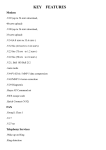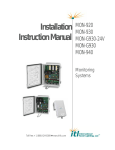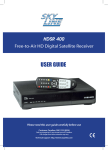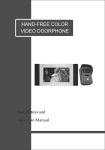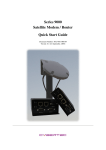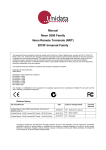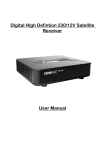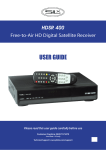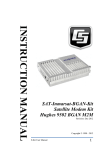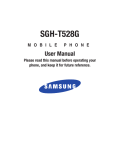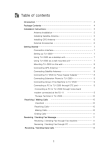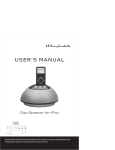Download Thuraya FDU-XT User Manual
Transcript
Table of Contents Table of Contents 1. Introduction 4 5.3. Ending Calls 15 2. Package Contents 4 5.4. Transferring Calls 15 3. Installation Instructions 5 5.5. Volume Control 16 3.1. Antenna Installation 5 5.6. Muting the microphone in speakerphone mode 16 3.2. Installing the Satellite Antenna 5 17 3.2.1. How to install the Satellite Antenna 5 6.1. Sending fax messages with a fax machine 17 3.2.2. How to align the Satellite Antenna 6 6.2. Receiving fax messages with a fax machine 17 3.3. Installing the GPS Antenna 8 6.3. Sending fax messages with a PC/Laptop 18 3.4. External Accessories 8 6.4. Receiving fax messages with a PC/Laptop 18 4. Getting Started 2ㅣ 6. Sending and receving fax messages 8 7. Receiving/Sending Data 18 7.1. Sending data from a PC/Laptop 19 10 7.2. Receiving data 19 4.3. Using FDU-XT as a wall mounted unit 11 8. GmPRS Connection 19 4.4. Start using the FDU-XT 11 9. Extension phone locking 23 4.5. Connecting an extension phone the FDU-XT 11 9.1. Enable extension phone locking 23 4.6. Connecting a Group 3 fax machine to the FDU-XT 12 9.2. Disable extension phone locking 23 4.7. Connecting a PC to Laptop to the FDU-XT 12 9.3. How to change the PIN code 23 4.8. Docking a Thuraya satellite phone 12 10. Troubleshooting 24 4.9. Undocking the handset from the FDU-XT 13 11. LED Indications 26 5. Receiving/Making Voice Calls 14 12. Warranty 26 5.1. Receiving Voice Calls 14 13. Specifications 28 5.2. Making Calls 15 4.1. External Connections 9 4.2. Connection Interface ㅣ 3 1. Introduction The FDU-XT (Fixed Docking Unit) is a home/office docking adapter that allows you to use Thuraya satellite services in indoor environments. It provides additional flexibility and convenience when using Thuraya XT-series handsets. In addition, FDU-XT and its accessories are designed to meet Thuraya’s specifications and quality standards. This indoor enabler enhances the capabilities of your Thuraya handset to meet your communication requirements, both in the home and in the office. When a Thuraya handset is used with FDU-XT, the handset becomes an indoor communication center providing voice, fax and data communication. GPS Antenna with Cable (25m) Support CD, USB Cable, RJ-11 Cable, FDU-XT User’s Manual 3. Installation Instructions After unpacking, please make sure that your FDU-XT and all its accessories are fully ready for installation. Please read the instructions carefully. If you encounter any difficulty in installation, contact your Service Provider for assistance. 2. Package Contents The FDU-XT package consists of the following items: 3.1. Antenna Installation The FDU-XT antenna set consists of the following components: AUS(Optional) FDU-XT with an Auxiliary Handset AC/DC Power Adapter 1. Satellite antenna with mounting adapter. 2. Satellite antenna cable to connect the satellite antenna to the FDU-XT (25m). 3. GPS antenna with attached coaxial cable to connect to the FDU-XT (25m). 3.2. Installing the Satellite Antenna The satellite antenna is a rectangular patch antenna and is supplied with mounting brackets. 3.2.1. How to install the Satellite Antenna Satellite Antenna and Mounting Adapter 4ㅣ Satellite Antenna Cable (25m) 1. Mount the antenna onto any suitable fixture (mounting pole or wall) using the provided mounting brackets and bolts. The antenna should face the Thuraya satellite (see 3.2.2 for antenna orientation). ㅣ 5 2. When installing the antenna, make sure the connectors are accessible when mounted. 3. Connect the coaxial cable to the antenna connector located at the base of the satellite antenna and tighten it properly by turning it clockwise. Leave enough length for a small loop and secure the rest of the cable using the cable ties. 4. Connect the other end of the satellite antenna cable to the reverse side of the FDU-XT marked “SAT”. Satellite based communication requires a direct line of sight to the satellite to achieve optimal signal strength. Therefore, the antenna must first be mounted in a location facing the satellite where it can then be finely adjusted for maximum reception. The locations of the Thuraya satellites are on a geostationary orbit (at the equator) at a more or less constant position: Thuraya-2 satellite at 44 degrees east of the zero meridian (approximately over Somalia) Thuraya-3 satellite at 98.5 degrees east of the zero meridian(approximately over Sumatra)cable ties. Antenna orientation: Align your antenna towards the Thuraya-2 satellite if your location is within the Thuraya-2 coverage area (Europe, Africa, Middle East). Align your antenna towards the Thuraya-3 satellite if your location is within the Thuraya-3 coverage area (Asia, Australia). In the overlapping areas, you can approach either of the two satellites and choose the satellite with the stronger signal. If you require an accurate antenna alignment, you can retrieve precise directions from your current location to the satellite (azimuth and elevation angle) by either of the following methods: 3.2.2. How to align the Satellite Antenna Satellite based communication requires a direct line of sight to the satellite to achieve optimal signal strength. Therefore, the antenna must first be mounted in a location facing the satellite where it can then be finely adjusted for maximum reception. 1. Acquire your current GPS position data with your Thuraya satellite phone (function ‘Current position’), press Option and send this data by SMS to the short code 1300. You will then receive the directional data from your location to the respective Thuraya satellite. 2. There are several independent websites where you can retrieve directional data to a specific satellite by entering your current location (www.dishpointer.com, www.satsig.net or others). The locations of the Thuraya satellites are on a geostationary orbit (at the equator) at a more or less constant position: 6ㅣ ㅣ 7 3.3. Installing the GPS Antenna 4.1. External Connections The GPS antenna comes with an attached coaxial cable to connect to the FDU-XT unit. 1. Find an appropriate location to mount the antenna. Make sure the antenna has a clear view of the sky. 2. Mark locations of the “screw holders” on the surface/rooftop for fixing the antenna. 3. Drill holes of adequate depth on the surface. 4. Keep the antenna in place so that the drilled holes and the screw holders line up. 5. Fix the antenna securely using the screws provided. 6. Connect the free end of the attached cable to the GPS antenna connector marked “GPS” on the reverse side of the FDU-XT. Note Maintain a distance of 0.5 to 1 meter between the GPS and SAT antenna. 3.4. External Accessories In order to use the FDU-XT, a Thuraya XT-series satellite phone with an active SIM-card is required. In addition the following external devices can be used with the FDU-XT: 1. Analogue extension phone 2. Selected Group3 fax machines with fax software for PC-fax 3. PC or laptop for data transfer and PC-fax Note The RJ-11 cable should be 2-wire inner at both ends. 4. Getting Started The FDU-XT is intended to be used as a desktop or wall-mounted phone while the Thuraya handset is docked. Slots are provided at the base of the unit to allow The FDU-XT to be hooked securely to a wall. Interfaces for connecting external equipments such as Group 3 fax machines and PCs are provided at the back side of the unit. 8ㅣ Attention 1. Do not connect FDU-XT with other products such as PSTN or a general telephone line. ㅣ 9 4.2. Connection Interface 4.3. Using FDU-XT as a wall mounted unit The FDU-XT can be fixed on the wall by using the included brackets. Slots for brackets are provided on the back of the FDU-XT. 1. Find an appropriate location on the wall to mount the FDU-XT. 2. Place the bracket on the fixing location and mark the location of the screw holes. 3. Place a suitable-length screw on the wall for mounting FDU-XT. 4. Change the direction of Handset holder to a wall-mounted unit. 5. Hook theFDU-XT to the bracket on the wall. Note This product contains an air ventilation fan. To ensure the fan’s normal operation, do not install the unit in a dusty area. 4.4. Start using the FDU-XT Plug in the attached power supply to an external power source and connect the power cable to the DC IN connector on the reverse side of the FDU-XT. Afterwards you are ready to switch on the FDU-XT on the reverse side of the unit. The blue power LED will be activated to indicate the power status of the FDU-XT. 4.5. Connecting an extension phone to the FDU-XT An alogue extension phone can be connected to the FDU-XT at the RJ-11 interface using the included RJ-11 cable. 10 ㅣ ㅣ 11 4.5. Connecting an extension phone to the FDU-XT An alogue extension phone can be connected to the FDU-XT at the RJ-11 interface using the included RJ-11 cable. 1. Plug one end of the RJ-11 cable to the RJ-11 interface marked “EXT” on the FDU-XT. 2. Connect the other end of the RJ-11 cable to the RJ-11 interface of the phone. 4.6. Connecting a Group 3 fax machine to the FDU-XT The FDU-XT can be used for sending and receiving fax messages when connected to selected Group 3 fax machines via RJ-11 interface. 1. Plug one end of the RJ-11 cable to the RJ-11 interface marked “FAX” on the FDU-XT. 2. Connect the other end of the RJ-11 cable to the Group 3 Fax machine. 4.8. Docking a Thuraya satellite phone 1. Before inserting the phone into the FDU-XT cradle please remove the rubber plugs of the antenna connector on the reverse side of the phone. After that fold back the bottom cover of the phone and attach it to the two small plastic pins. 2. Place the Thuraya satellite phone into the cradle with the display facing up while attaching it to the connectors. 3. If the handset has been docked successfully, the display of the phone will show "Fixed Adapter". 4. Ensure you have full signal strength on the display (otherwise try to adjust the direction of the antennas). Note Ensure that the dust caps on the reverse side and on the bottom side of the Thuraya handset are removed before docking. Note Contact your Service Provider to register fax services on your SIM card. 4.9. Undocking the handset from the FDU-XT 4.7. Connecting a PC or Laptop to the FDU-XT You can connect your FDU-XT to a PC or Laptop through the USB or DTE interface on the reverse side of the FDU-XT. 1. Plug in one end of the USB cable (or Serial cable) to the USB port (or COM port) of your PC. 2. Connect the other end of the USB cable (or Serial cable) to the USB interface (or DTE interface) of the FDU-XT. Your FDU-XT has a locking function to prevent unwanted removing of the handset from the FDU-XT. The handset can only be removed if the lock is opened. To remove the phone after unlocking: 1. Allow the handset to complete all ongoing functions. 2. Press the Eject button to release the handset Note To use the USB interface, please install the USB drivers for the FDU-XT first on your PC. The drivers can be found on the Support CD provided with the product. Contact your Service Provider to register data services on your SIM card. 12 ㅣ ㅣ 13 5. Receiving / Making Voice Calls Before you can make and receive voice calls, please make sure the following steps have been checked: 1. The FDU-XT is switched on 2. The Thuraya handset is switched on 3. The SIM card is valid and working. 4. The connections are properly set-up as described in the previous steps. 5. The Thuraya handset is properly docked in the FDU-XT as described in the previous steps. 6. Adequate satellite and GPS signal strength is available (see display of the handset). 5.2. Making Calls Calling from the Speakerphone 1. Dial the destination number using the keypad of the Thuraya handset. 2. Press the Call button ( ) on the Thuraya handset. Calling from the Auxiliary Handset Method 1 1. 2. 3. 4. Pick up the auxiliary handset. Wait for the dial tone. Dial the destination number using the Thuraya handset keypad. Press call button on Thuraya handset. Method 2 5.1. Receiving Voice Calls Incoming calls are indicated by: 1. Ringing tone from the speakerphone (and optionally from the extension phone if attached) 2. Flashing of the speakerphone LED. You can accept incoming calls trough the speakerphone, auxiliary handset, or extension phone. Note The speakerphone LED will remain ON if the call was not answered. 1. Dial the destination number using Thuraya handset keypad while the auxiliary handset is on the cradle. 2. Pick up the auxiliary handset. Calling from the Extension Phone 1. Pick up the handset of the Extension phone. 2. Wait for the dial tone. 3. Dial the destination number on the Extension phone keypad. 4. Press (*or #) on the Extension phone keypad after entering the numbers. 5.3. Ending Calls Ending a Speakerphone Call Press the Speakerphone button. Accepting Calls from the Auxiliary Handset Pick up the Auxiliary handset. Ending calls with the auxiliary handset Hang up the auxiliary handset Ending calls with an extension phone Hang up the extension phone Accepting Calls from the Speakerphone 5.4. Transferring Calls Accepting Calls from Extension Phone Speakerphone to Auxiliary Handset Press the Speakerphone button. Pick up the handset of the Extension phone. 14 ㅣ 1. Pick up the Auxiliary handset during the call. The call will be routed to the auxiliary handset. ㅣ 15 Auxiliary Handset to Speakerphone 1. Press the speakerphone button on the FDU-XT during a call. 2. Ensure the speakerphone LED is blinking, afterwards hang up the auxiliary handset. Note If you pick up the auxiliary handset now, the call will be automatically unmuted and routed to the auxiliary handset. Speakerphone to Extension Phone 1. Pick up the Extension phone handset. Extension Phone to Speakerphone To Un-mute the call Press the Mute button again. 1. Press the speakerphone button on the FDU-XT during a call. 2. Ensure the speakerphone LED is blinking, afterwards hang up the extension phone. 5.5. Volume Control You can adjust the volume of the speakerphone, auxiliary handset and ringtone using the Volume Up and Volume Down button on the FDU-XT. Adjusting auxiliary handset volume 1. Pick up the auxiliary handset. 2. Press the Volume ‘Up’/Volume ‘Down’ button repeatedly to increase/decrease the auxiliary handset volume as required. Adjusting speakerphone volume 1. Switch ‘ON’ the speakerphone. 2. Press the Volume ‘Up’/Volume ’Down’ button repeatedly to increase/decrease the speakerphone volume as required. 6. Sending and receving fax messages Your FDU-XT supports sending and receiving fax messages either by a connected Group3 fax machine or a connected PC/Laptop with fax software. 6.1. Sending fax messages with a fax machine 1. Dock your Thuraya handset into the FDU-XT 2. Switch on the Group3 fax machine connected via the RJ-11 interface. 3. Switch on the FDU-XT. 4. Place the fax sheet in the fax machine and dial the destination number followed by * or #. 5. Press the start button on the fax machine. Adjusting ringtone volume 1. Select the ringtone of your Thuraya handset from the handset menu. 2. Switch the speakerphone on. 3. Press the 'Volume Up'/'Volume Down' buttons repeatedly to increase/decrease the rintone volume. 5.6. Muting the microphone in speakerphone mode You can mute the microphone while in speakerphone mode by pressing the mute button. You will then be able to hear the caller at the other end but the other party will not be able to hear you. 16 ㅣ 6.2. Receiving fax messages with a fax machine 1. Dock your Thuraya handset into the FDU-XT 2. Switch on the FDU-XT 3. Switch on the Group3 fax machine that is connected via the RJ-11 interface. Note A ringtone in the fax machine indicates an incoming fax call. ㅣ 17 6.3. Sending fax messages with a PC/Laptop 1. Dock your Thuraya handset into the FDU-XT. 2. Connect the PC to the USB or DTE serial interface of the FDU-XT. 3. Switch on the FDU-XT. 4. Start the PC fax software 5. While configuring the fax software, select 'fine' as resolution. 6. Enter the destination number. 7. Select the document to be sent. 8. Use the respective start function of the fax software to start transmitting the fax. Note While sending a fax through PC connected at the USB or DTE interface, the fax software should be configured in the class 2.0 mode. When sending a fax through Quick Link or Hot Fax, select “Thuraya Mobile Phone” or “Standard 19200 Modem” as a modem. 6.4. Receiving fax messages with a PC/Laptop 1. Dock your Thuraya handset into the FDU-XT. 2. Connect the PC to the USB or DTE serial interface of the FDU-XT. 3. Switch on the FDU-XT. 4. Activate the fax software on the PC/Laptop. 5. If there is no Group3 fax machine connected to the FDU-XT, all incoming fax messages will be received by the connected PC/Laptop. 7. Receiving/Sending Data You can use your FDU-XT to receive and make data calls through a PC connected at the USB or DTE interface. To receive/make data calls by a PC, appropriate data communication software needs to be installed on the PC. Note The baud rate of the PC data communication software should be set at 19200bps. 18 ㅣ 7.1. Sending data from a PC/Laptop 1. Dock your Thuraya handset into the FDU-XT. 2. Connect the PC to the USB or DTE serial interface of the FDU-XT. 3. Switch on the FDU-XT. 4. Start the data communication software of your PC. 5. Enter the destination number. 6. Select the data file to be sent. 8. Use the respective start function of the data communication software to start transmitting the file. 7.2. Receiving data 1. Dock your Thuraya handset into the FDU-XT. 2. Connect the PC to the USB or DTE serial interface of the FDU-XT. 3. Switch on the FDU-XT. 4. Start the data communication software on the PC/Laptop. 5. You will hear a special signal on the docked Thuraya handset when a data call is arriving. 8. GmPRS Connection With your FDU-XT you can access Thuraya’s GmPRS network. Use the USB or serial DTE port to connect the FDU-XT to your PC or laptop. Setting a phone connection modem to access Thuraya’s GmPRS network 1. Select “Control Panel Phone and Modem Option Modems” and then set a port by adding the “Standard 33600bps Modem” according to the following procedures. ㅣ 19 2. Right-click the mouse on the “Standard 33600bps Modem” which is newly created in the Modems window. Right-click the mouse to select “Properties” and then select “38400” for “Maximum Port Speed”. Control panel network connections 4. Once all the settings are complete, a new phone connection icon will be generated on the main screen. 5. Double-click the newly generated phone connection icon to execute phone connection. Select “Properties General Configure” and then set “38400” for “Maximum Modem Speed”. create a new connection 3. Select“ Control Panel Network Connections Create a new connection” to automatically execute the “New Connection Wizard”. Follow the procedures below to create a phone connection. (Make sure to enter “*99#” for “Phone Number to Dial”) 20 ㅣ ㅣ 21 6. Select “Internet Protocol Properties” again and then select “Obtain an IP address automatically”. 9. Extension phone locking If you use an external extension phone in combination with the FDU-XT, you can protect the usage of the extension phone with a PIN code. After activating the PIN locking function, a user will have to enter the correct PIN in order to make a phone call from the extension phone. The PIN code of the FDU-XT is per default set to "0000". If the extension phone locking is enabled use the following procedure to make a call: On the extension phone enter the PIN code telephone number -> or # (e.g.: 0000 123456789 ) 9.1. Enable extension phone locking: Procedure to access Thuraya’s GmPRS network 1. Click the phone connection icon on the main screen or from the program. 2. See if the dial number is set to “*99#” and then click “Dial”. 1. Connect the extension phone to the RJ-11 interface marked "EXT" on the reverse side of the FDU-XT. PIN (e.g.: 0000 ) 2. Press 3. Hang up the phone after hearing the beep which indicates the activation of the PIN code. 9.2. Disable extension phone locking: 1. Connect the extension phone to the RJ-11 interface marked "EXT" on the reverse side of the FDU-XT. PIN (e.g.: #0000 ) 2. Press # 3. Hang up the phone after hearing the beep which indicates the deactivation of the PIN code. 9.3. How to change the PIN code 3. Afterwards the icon "Phone Connection Network" will be shown on the Windows task bar and on the Thuraya handset you will see the "G" symbol. Procedure to disconnect from Thuraya’s GmPRS network 1. Click on the icon "Phone Connection Network" on the Windows task bar and then select "End". 22 ㅣ 1. Connect the extension phone to the RJ-11 interface marked "EXT" on the reverse side of the FDU-XT. Old PIN (4 digits) New PIN (4 digits) (e.g.: # 0000 1234 ) 2. Press # 3. Hang up the phone after hearing the beep which indicates the confirmation of the PIN change. Please make sure you do not forget the new PIN code, otherwise you need to bring the FDUXT to the Service Center in order to reset the unit. ㅣ 23 10. Troubleshooting Your FDU-XT does not contain consumer serviceable components. You are advised not to carry out any kind of troubleshooting. In case you face any problems, contact the nearest service center. Only authorized service personnel can repair the equipment. Use only the antennas and cables that have been provided with the unit or that have been specifically designed for your FDU-XT. Unauthorized antennas, cables and cable length modification or attachments could damage the FDU-XT and may violate the relevant regulations, causing loss of performance and radio frequency (RF) energy above the recommended limits. If your FDU-XT’s antenna gets damaged, please take it to an authorized Service Provider. Do not place the FDU-XT in a wet area. Do not expose the FDU-XT to temperatures higher than +55°C Celsius or less than 0°C Celsius. Do not expose the FDU-XT to moisture, dust etc. Do not expose the FDU-XT to direct sunlight. Do not disassemble the FDU-XT; this will void your warranty. Do not store it in hot areas. High temperatures can shorten the life of electronic devices, damage batteries, and warp or melt certain plastics. Do not drop, apply pressure or shake it. Rough handling can break internal circuit boards. Do not use chemicals, cleaning solvents, or strong detergents to clean it. Wipe it smoothly with a soft cloth. Do not paint it. Paint can clog the device’s moving parts and prevent proper operation. If the FDU-XT, the phone, battery, charger or any accessory does not function properly, take it to your nearest authorized service center. The personnel there will assist you, and if necessary, arrange for service. 24 ㅣ Common Problems Thuraya handset is not properly docked. Thuraya handset is switched OFF. There is not enough satellite signal strength (minimum of two bars should be shown on the handset display, otherwise adjust the antenna). FDU-XT is not switched ON. Connections are not proper and firm. Problem Solution Check if PIN locking is enabled and if PIN code is correct. Check if the RJ-11 cable is properly connected (when using an Unable to extension phone). make/receive If the extension phone is not working, try to use the auxiliary calls handset. If you are able to make/receive calls with the auxiliary handset, please check the functioning of the extension phone. The auxiliary handset Check whether the auxiliary handset is connected properly. is not working Speakerphone not working Make sure that the speakerphone is “ON”. Select appropriate volume level. Check if PIN locking is enabled and if PIN code is correct. Check if the RJ-11 cable is properly connected. Unable to send/receive fax through RJ-11 Check if the fax machine is switched on and is functional. Make sure that the Group3 fax machine is in auto response mode. Check if the SAT signal level on the Thuraya handset is adequate. Please note that not all Group3 fax machines are able to handle mobile transmission. Unable to send/receive fax through PC Make sure that you have appropriate PC Fax software installed in your system for sending/receiving fax through PC. Check parameters on the fax software that you are using. ㅣ 25 11. LED Indications 12. Warranty LED Status Indication The blue Power LED ( ) is on. FDU-XT is switched on The blue battery LED ( ) is on. Handset battery is fully charged The blue battery LED ( ) is blinking. Handset battery is charging The white speakerphone LED is flashing. Incoming call The white LED on the speaker button ( The white LED on the mute button ( ) is on. ) is on. Speakerphone is on Microphone is off Limited Warranty FDU-XT This Limited Warranty is provided to the original purchaser of FDU-XT. This Limited Warranty is nontransferable in nature. Warranty Coverage and Service APSI warrants all new FDU-XT handsets to be free from defects in material and Workmanship under normal use and wear for a period of one year (1 year) from the date of purchase. If under normal use the product becomes defective in materials or workmanship and is returned to APSI Authorized Service Center during the warranty period, the product will be repaired or replaced at no charge to the purchaser. The purchaser shall be required to provide reasonable proof of the date of purchase of the product. Repair or replacement of the Product is subject to APSI System Design’s sole and exclusive option. Reconditioned replacement components, parts, units, or materials may be used if the Product is repaired or replaced. Cost incurred in the removal, de-installation or reinstallation of the Product are not covered. This Limited Warranty will be void in its entirety if the Product is serviced by anyone other than APSI or an APSI Authorized Service Center. The User’s sole and exclusive solution will be repair or replacement of the product. APSI neither assumes nor authorizes any Authorized Service Center or any other person or entity to assume any other obligation or liability beyond that which has been specified in this Limited Warranty. Limitation of Liability All liability and obligations of APSI under this Limited Warranty shall terminate on the completion of the warranty period of one year, calculated from the date of purchase of the product by the original purchaser. The purchaser shall fill in the warranty card attached in the User’s manual and get it duly stamped and signed by the Dealer as proof of purchase. This limited warranty sets forth the entire responsibility of APSI with respect to the product. There are no other liabilities of APSI arising from the sale of the Product whether based on warranty, contract, negligence or any other theories of liability. This Warranty does not cover the following APSI will not be responsible for products or accessories not manufactured or provided by APSI or Thuraya. APSI will not take responsibility for the failures caused by misuse, accident, alteration or neglect, removal or repair, neglect or failure to follow instructions as to installation and maintenance, fire, flood or other natural calamities. APSI will not guarantee the performance of the product when used in combination with other non authorized products or equipment. 26 ㅣ ㅣ 27 13. Specifications 28 ㅣ
















